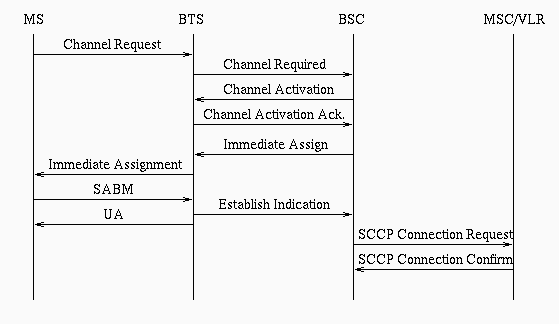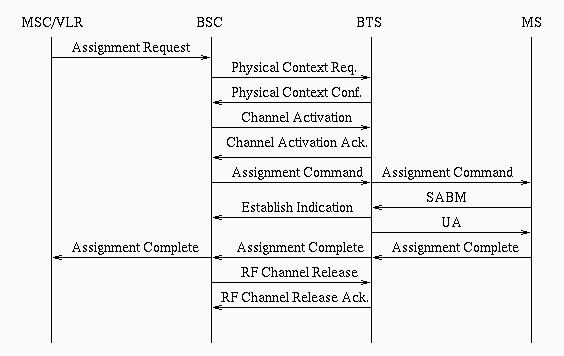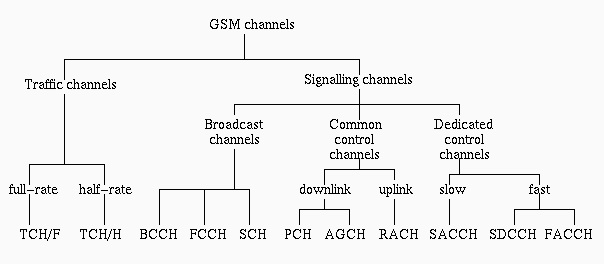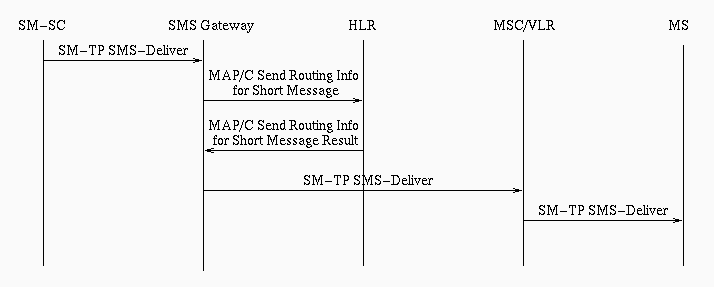
Each task (T1...T10) is graded as pass/fail and at least 60% of the tasks must be passed to achieve +1 increment on the course score. Good references for this work are Mouly's book and also http://download.wg.com/brochures/gsm.pdf.
The BSS is located between two interfaces, Air and A. From the call establishment point of view, the MS must have a connection through these two interfaces before a call can be established. The MS starts the sequence by sending a message 'Channel Request'. This message contains a reason why the signalling connection through the BSS is needed. After this, the BSC allocates a signalling channel through so-called A-bis interface located between the BTS and the BSC. When the signalling channel is ready through the A-bis interface, the MS is told to move to the signalling channel in the Air interface. The MS informs it is on the signalling channel which then triggers the BSC to set up the A interface, i.e. the BSC requests the SCCP connection. When a signalling connection between the MS and the NSS has been opened as described, the MS starts the other signalling sequences in order to completed the original requested task.

In the case of a Mobile Terminated Call, the MSC sends a 'Set-up' message to the MS in order to inform the MS about an incoming call and its nature. The MS accepts the call by sending the message 'Call Confirmed'.

The MSC allocates a traffic channel through the BSS for subscriber B.

Lähde: prujut s.69-70

Functions of different:
a) Traffic channels:
full-rate channel (TCH/F): Carries user data (speech and data)
half-rate channel (TCH/H): Carries user data (speech and
data). Half-rate TCHs double the capacity of a system effectively by
making it possible to transmit two calls in a single channel.
b) Signalling channels:
Broadcast channels:
The broadcast channels (BCH) carry only downlink information and are
responsible mainly for synchronization and frequency correction. This
is the only channel type enabling point-to-multipoint communications
in which short messages are simultaneously transmitted to several
mobiles.
The BCHs include the following channels:
BCCH:
Broadcast control channel (BCCH): General information, cell-specific;
e.g. local area code, network operator, access parameters, list of
neighbouring cells, etc. The MS receives signals via the BCCH from
many BTSs within the same network and/or different networks.
FCCH:
Frequency correction channel (FCCH): Downlink only; correction of MS
frequencies; transmission of frequency standard to MS; it is also used
for synchronization of an acquisition by providing the boundaries
between timeslots and the position of the first timeslot of a TDMA
frame.
SCH:
The synchronization channel (SCH): Downlink only; frame
synchronization (TDMA frame number) and identification of base
station. The valid reception of one SCH burst will provide the MS with
all the information needed to synchronize with a BTS.
Common control channels:
The common control channels (CCCH): A group of uplink and downlink
channels between the MS card and the BTS. These channels are used to
convey information from the network to MSs and provide access to the
network.
The CCCHs include the following channels:
PCH:
The paging channel (PCH): Downlink only; the MS is informed by the BTS
for incoming calls via the PCH.
AGCH:
The access grant channel (AGCH): Downlink only; BTS allocates a TCH or
SDCCH to the MS, thus allowing the MS access to the network.
RACH:
The random access channel (RACH): Uplink only; allows the MS to
request an SDCCH in response to a page or due to a call; the MS
chooses a random time to send on this channel. This creates a
possibility of collisions with transmissions from other MSs.
Dedicated control channels:
The dedicated control channels (DCCH): Responsible for e.g. roaming,
handovers, encryption, etc.
The DCCHs include the following channels:
SDCCH:
The stand-alone dedicated control channel (SDCCH): Communications
channel between MS and the BTS; signaling during call setup before a
traffic channel (TCH) is allocated.
SACCH:
The slow associated control channel (SACCH): Transmits continuos
measurement reports (e.g. field strengths) in parallel to operation of
a TCH or SDCCH; needed, e.g for handover decisions; always allocated
to TCH or SDCCH; needed for "non-urgent" procedures, e.g. for radio
measurement data, power control (downlinkonly), timing advance, etc.;
always used in parallel to a TCH or SDCCH.
FACCH:
The fast associated control channel (FACCH): Similar to th SDCCH, but
used in parallel to operation of the TCH; if the data rate of the
SACCH is insufficient, "borrowing mode" is used: Additional bandwidth
is borrowed from the TCH; this happens for messages associated with
call establishment authentication of the subscriber, handover
decisions, etc.
Lähde: gsm.pdf s.16-20
The frames include redundancy bits to enable a receiver to detect remaining errors, and this is the basis for a repetition-when-needed correction scheme, the RLP protocol (Radio Link Protocol). This protocol is operated between the TAF (Terminal Adaptation Functions) (sijaitsee Terminal Adaptorissa, joka taas on kiinni päätelaitteessa) and the IWF (Interworking Functions). (The Interworking Functions as a function lies somewhere between the MSC and the external network). In rough terms, the user data stream (including auxiliary information) is sliced in blocks of 200 bits, sprinkled with some redundancy and sent to the other end within frames of 240 bits. Each frame is numbered. When received, the frame is tested for correctness thanks to the redundancy. If found correct, the receiver acknowledges the reception (using the frame number). If not, a negative indication (either explicit, or by default) is received by the sender which tries again. RLP is basically a link protocol, such as those used for the transport of signalling messages.
Lähteet: kirja s.169, 281-282 ja 150
The concept of IN dates back to the early 1980's, when it became apparent that the contemporary stored program control exchanges were not suitable for rapid introduction of new services, as every switch had to be re-programmed when services were introduced. This inevitably led to a paucity of new services and a degree of network vendor-dependence. Consequently, it became clear that switching and service intelligence had to be separated.
The CCITT objectives for the new IN architectural concept are [GARRA93]:
It was studied as part of MoNET, and is now specified in the Q.1200 series of the ITU-T recommendations.
The intelligent network separates service control and service data from basic call control. Service control is then activated by 'trigger points' in the basic call.
This means that services can be developed on computers independent of the network switches responsible for basic call and connection control. This gives flexibility to the network operators and service providers, as well as the potential to support the services on any network that supports the trigger points.
Eventually, IN can be expanded to control the network itself, such as handling all UMTS mobile functions. Any network supporting the intelligent network service set will be able to support new services using that service set easily, making integration of networks easier and transparent to the user of those services.
The IN is thus an important factor in the integration of B-ISDN and UMTS. UMTS, B-ISDN and the intelligent network set are all being developed at the same time, allowing each to influence the others in producing a coherent, integrated whole.
It was mentioned above that Intelligent Networks technology facilitates the rapid introduction of new and innovative services; this is obviously a major advantage for users as it provides them with services which under the system of stored program exchanges would have taken substantially longer to implement. Also, in the new environment of rapid service introduction, users will play a much more influential role in deciding which sort of services will be implemented. As service provision becomes less the role of the network operator and more the role of the many service providers, it is the user who will decide which services offer the most for their money.
a) emergency service (call 112)
Emergency calls are made by dialling 112, the number being agreed as
the standard emergency number throughout Europe, to reach the nearest
emergency service.
b) operator service (call 118)
Lähde: http://www.fen.bris.ac.uk/elec/UMPTIDUMPTI/data/deliverables/d07/body.html
The paging channel is divided into sub-channels. The mobiles are classified into different groups based on the IMSI and need only listen to the paging sub-channel allocated to its group. This is called discontinuous reception (DRX) and is intended to reduce the power usage in the mobile while it is idle.
Lähde: http://www.item.ntnu.no/~palat/GSM/node37.html
Supplementary services are provided on top of teleservices or bearer services, and include features such as caller identification, call forwarding, call waiting, multiparty conversations, and barring of outgoing (international) calls, among others.
GSM Supplementary Services are designed to increase productivity. They are simple to activate. Simple to use, and can be uased by all GSM Subscribers.
a)Call Forwarding
Have your calls follow you wherever you go to any phone number
(Ordinary or GSM). Call Forwarding Types:
b) Barring of outgoing calls
You can bar outgoing calls or incoming calls by using a four digit
barring code. The following categories of calls can be barred.
c) Advice of charge
Provides the user with an online charge information.
Lähde: http://www.etisalat.co.ae/gsmpage.htm, http://kbs.cs.tu-berlin.de/~jutta/gsm/js-intro.html, http://www.comms.eee.strath.ac.uk/~gozalvez/gsm/gsm.html#6.3
GSM networks presently operate in three different frequency ranges. Your phone and the SIM inside it will only work in an area which uses the same GSM frequency. These are:
GSM 900:
Uplink: 890-915 MHz (= mobile station to base station)
Downlink: 935-960 MHz (= base station to mobile station)
Esimerkkimaa: Tanska
GSM 1800 (previously DCS-1800):
Uplink: 1710-1785 MHz
Downlink: 1805-1880 MHz
Esimerkkimaa: Ranska
GSM 1900 (previously PCS-1900):
Uplink: 1850-1910 MHz
Downlink: 1930-1990 MHz
Esimerkkimaa: Kanada
Lähde eroihin: http://www.gsmdata.com/roaming.htm
Lähde linkkeihin: gsm.pdf s.13-14
Lähde maihin: http://cellular.co.za/gsm_networks-d-i.htm
ja http://www.mobileoffice.co.za/gsm_networks-a-c.htm

A short message addressed to a GSM subscriber must first be routed from the sender to a Short Message Centre, and from then be routed to the actual destination.
When the SM-SC has a message to send to some GSM subscriber, it builds a SM-TP SMS-DELIVER message, containing various pieces of information for the benefit of the recipient. This information includes in particular the user content , the identification of the original sender, and a time-stamp indicating when the message was received by the MS-SC. Similarly with the Mobile Originating case, the SM-TP SMS-DELIVER message will be transferred on various interfaces, using the capabilities of lower layer protocols. In particular to convey the acknowledgement back to the SM-SC.
Before the SM-TP SMS-DELIVER message can reach its destination (the mobile station), its actual routing must be derived using the interrogation functions of MAP/C. This is achieved in the following manner. The SM-SC conveys the short message to an SMS-gateway to which the service center is connected, which it chooses depending on the subscriberit wants to reach, since most often a gateway will be able to deal with only some of the subscribers (for instance those of some country, or some operator). The subscriber is then identified by his directory number (the same MSISDN as for telephony, typically), entered originally by the originator of the message. This enables the SMS-gateway to identify the relevant HLR and interrogate it. The interrogation is done by sending a special message, the MAP/C SEND ROUTING INFO FOR SHORT MESSAGE message. This is answered by either the corresponding MAP/C SEND ROUTING INFO FOR SHORT MESSAGE RESULT message, which contains an SS7 address pertaining to the MSC/VLR where the subscriber is visiting, or by rejection message if the subscriber is known not to be reachable at this instant.
Lähde: kirja s.560
What kind of telephone data connection; does the computer have this
kind of connection?
The most common connection at present is a PCMCIA card, a
credit-card-sized connection card. The market also supplies phones
which can be connected to ordinary serial interface gates (serial
interface is a standard feature of every computer). Both connections
function as reliably, and there is no difference between them for the
end-user. The advantage of PCMCIA card is that a number of different
equipment, such as wireline network modems, LAN cards, replaceable
hard disks, etc., can be connected to the same connection.
What is unique about the Option GSM-Ready PC Card modem?
This is the first and only device in the world to squeeze a high-speed
analogue data/fax modem and a GSM digital data/fax adapter into a
single PCMCIA card. To use it on the analogue PTT networks, you simply
plug in the supplied RJ-11 cable. To use it on the digital GSM
cellular networks, simply plug in the cable for the particular
cellphone you are going to use it with. Supports Nokia, Siemens,
Ericsson, Panasonic. No settings changes what-so-ever are required for
alternate use on either type of network.
Infrapunamodeemi
ERICSSON DI 27 INFRARED MODEM.
The Ericsson DI27 Infrared modem is a small,
powerful and reliable modem that utilises infrared light
to transmit data between a mobile phone and handheld PC.
GSM mobile phones can be used for data transmission at up to 9600 bps. Advanced phones provide an internal modem with infrared port. No cable needed to connect your cell phone to your laptop !
Radiolinkki
"Bluetooth" is a new standard launched in May 1998 which utilises a
short-range radio link to exchange information, enabling effortless
wireless connectivity between mobile phones, mobile PCs, handheld
computers and other peripherals. The Bluetooth SIG (Special Interest
Group) was formed in early 1998 as a result of the global commitment
of the five founding companies to develop the concept towards a
technology standard. It competes with the 802.11 specification for
wireless networking.
Lähde: http://www.teleadapt.com/aus/nme/products.htm, http://www.geocities.com/TheTropics/Lagoon/5483/gsm.htm ja http://www.mobileoffice.co.za/bluetooth.htm
Note! In those cases where signaling chart is requested, it is enough
to draw lines between elements, name the message, and explain with one
sentence what this message does or means.